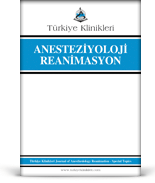Objective: Fast-track and balanced anesthesia protocols have been developed in years, in cardiac surgery. Conventional high-dose fentanyl and midazolam techniques lost their popularity because of several known side effects. The primary aim of this study is; to compare traditional and balanced anesthesia protocols in terms of postoperative pain and sedation scales and early extubation criterias. The secondary aim is to observe the effects of these two different anesthesia protocols on intraoperative hemodynamics. Material and Methods: Conventional anesthesia group patients were administered 10 μg kg-1 fentanyl, 0.15 mg kg-1 midazolam as anesthesia induction; 3 μg kg-1 fentanyl and 0.01-0.05 mg kg-1 midazolam as anesthesia maintenance. Balanced anesthesia group patients were administered propofol 2 mg kg-1, ketamine 1 mg kg-1 as anesthesia induction; continuous infusion of remifentanil and sevoflurane as anesthesia maintenance. Patients were evaluated in terms of intraoperative hemodynamic parameters. In addition; pain, sedation, and extubation criteria were evaluated at postoperative 2nd hour. Results: Forty-nine adult patients who underwent coronary surgery were analyzed. Intraoperative hemodynamics were similar in both groups. However, the rates of total nitroglycerine and ephedrine doses were found to be significantly higher in the group conventional (p<0.001, p=0.013). In addition, postoperative sedation scores and the rate of patients who didnot meet extubation criteria were higher in the conventional group (p<0.001). Conclusion: Our balanced anesthesia management protocol seems to provide intraoperative hemodynamic stability, in addition, beter postoperative recovery in coronary surgery patients.
Keywords: Cardiac anesthesia; fentanyl; midazolam; propofol; remifentanil
Amaç: Kalp cerrahisinde yıllar içinde hızlı ve dengeli anestezi protokolleri geliştirilmiştir. Konvansiyonel yüksek doz fentanil ve midazolam teknikleri, bilinen birçok yan etkileri nedeniyle popülerliğini yitirmiştir. Bu çalışmanın birincil amacı, geleneksel ve dengeli anestezi protokollerini intraoperatif hemodinami ve postoperatif klinik sonuçlar açısından karşılaştırılmasıdır. İkincil amacı ise bu iki farklı anestezi protokolünün intraoperatif hemodinamikler üzerine etkisinin gözlenmesidir. Gereç ve Yöntemler: Konvansiyonel anestezi grubundaki hastalara anestezi indüksiyonu olarak 10 μg kg-1 fentanil, 0,15 mg kg-1 midazolam; anestezi idamesi olarak 3 μg kg-1 fentanil ve 0,01-0,05 mg kg-1 midazolam uygulandı. Dengeli anestezi grubundaki hastalara anestezi indüksiyonu olarak propofol 2 mg kg-1, ketamin 1 mg kg-1; anestezi idamesi olarak remifentanil infüzyonu ve sevofluran uygulandı. Hastalar intraoperatif hemodinamik parametreler açısından değerlendirildi. Ek olarak, ağrı, sedasyon ve ekstübasyon kriterleri postoperatif 2. saatte değerlendirildi. Bulgular: Koroner cerrahi uygulanan 49 erişkin hasta analiz edildi. İntraoperatif hemodinami her iki grupta da benzerdi. Ancak kullanılan toplam nitrogliserin ve efedrin doz oranları konvansiyonel grupta anlamlı olarak yüksek bulundu (p<0,001, p=0,013). Ayrıca postoperatif sedasyon skorları ve ekstübasyon kriterlerini karşılamayan hasta oranı konvansiyonel grupta daha yüksekti (p<0,001). Sonuç: Dengeli anestezi yönetim protokolümüzün, koroner cerrahi hastalarında daha iyi intraoperatif hemodinamik stabilitenin, bunun yanında daha iyi postoperatif iyileşme sağladığı sonucuna vardık.
Anahtar Kelimeler: Kardiyak anestezi; fentanil; midazolam; propofol; remifentanil
- Basagan-Mogol E, Goren S, Korfali G, Turker G, Kaya FN. Induction of anesthesia in coronary artery bypass graft surgery: the hemodynamic and analgesic effects of ketamine. Clinics (Sao Paulo). 2010;65(2):133-8. [Crossref] [PubMed] [PMC]
- Myles PS. Evaluating interventions to reduce the risk of postoperative delirium. Br J Anaesth. 2020;125(1):4-6. [Crossref] [PubMed]
- Jakobsen CJ, Berg H, Hindsholm KB, Faddy N, Sloth E. The influence of propofol versus sevoflurane anesthesia on outcome in 10,535 cardiac surgical procedures. J Cardiothorac Vasc Anesth. 2007;21(5):664-71. [Crossref] [PubMed]
- Hudetz JA, Patterson KM, Iqbal Z, Gandhi SD, Byrne AJ, Hudetz AG, et al. Ketamine attenuates delirium after cardiac surgery with cardiopulmonary bypass. J Cardiothorac Vasc Anesth. 2009;23(5):651-7. [Crossref] [PubMed]
- Nguyen J, Nacpil N. Effectiveness of dexmedetomidine versus propofol on extubation times, length of stay and mortality rates in adult cardiac surgery patients: a systematic review and meta-analysis. JBI Database System Rev Implement Rep. 2018;16(5):1220-39. [Crossref] [PubMed]
- Botero CA, Smith CE, Holbrook C, Chavez AM, Snow NJ, Hagen JF, et al. Total intravenous anesthesia with a propofol-ketamine combination during coronary artery surgery. J Cardiothorac Vasc Anesth. 2000;14(4):409-15. [Crossref] [PubMed]
- Myles PS, Daly DJ, Djaiani G, Lee A, Cheng DC. A systematic review of the safety and effectiveness of fast-track cardiac anesthesia. Anesthesiology. 2003;99(4):982-7. [Crossref] [PubMed]
- Maldonado JR, Wysong A, van der Starre PJ, Block T, Miller C, Reitz BA. Dexmedetomidine and the reduction of postoperative delirium after cardiac surgery. Psychosomatics. 2009;50(3):206-17. [Crossref] [PubMed]
- Engelman DT, Ben Ali W, Williams JB, Perrault LP, Reddy VS, Arora RC, et al. Guidelines for perioperative care in cardiac surgery: enhanced recovery after surgery society recommendations. JAMA Surg. 2019;154(8):755-66. [Crossref] [PubMed]
- Grant MC, Isada T, Ruzankin P, Gottschalk A, Whitman G, Lawton JS, et al. Opioid-sparing cardiac anesthesia: secondary analysis of an enhanced recovery program for cardiac surgery. Anesth Analg. 2020;131(6):1852-61. [Crossref] [PubMed]
- Cheng DC, Karski J, Peniston C, Asokumar B, Raveendran G, Carroll J, et al. Morbidity outcome in early versus conventional tracheal extubation after coronary artery bypass grafting: a prospective randomized controlled trial. J Thorac Cardiovasc Surg. 1996;112(3):755-64. [Crossref] [PubMed]
- Roytblat L, Talmor D, Rachinsky M, Greemberg L, Pekar A, Appelbaum A, et al. Ketamine attenuates the interleukin-6 response after cardiopulmonary bypass. Anesth Analg. 1998;87(2):266-71. [Crossref] [PubMed]
- Cho JE, Shim JK, Choi YS, Kim DH, Hong SW, Kwak YL. Effect of low-dose ketamine on inflammatory response in off-pump coronary artery bypass graft surgery. Br J Anaesth. 2009;102(1):23-8. [Crossref] [PubMed]
- Welters ID, Feurer MK, Preiss V, Müller M, Scholz S, Kwapisz M, et al. Continuous S-(+)-ketamine administration during elective coronary artery bypass graft surgery attenuates pro-inflammatory cytokine response during and after cardiopulmonary bypass. Br J Anaesth. 2011;106(2):172-9. [Crossref] [PubMed]
- Lison S, Schill M, Conzen P. Fast-track cardiac anesthesia: efficacy and safety of remifentanil versus sufentanil. J Cardiothorac Vasc Anesth. 2007;21(1):35-40. [Crossref] [PubMed]
- Kwanten LE, O'Brien B, Anwar S. Opioid-based anesthesia and analgesia for adult cardiac surgery: history and narrative review of the literature. J Cardiothorac Vasc Anesth. 2019;33(3):808-16. [Crossref] [PubMed]







.: Process List